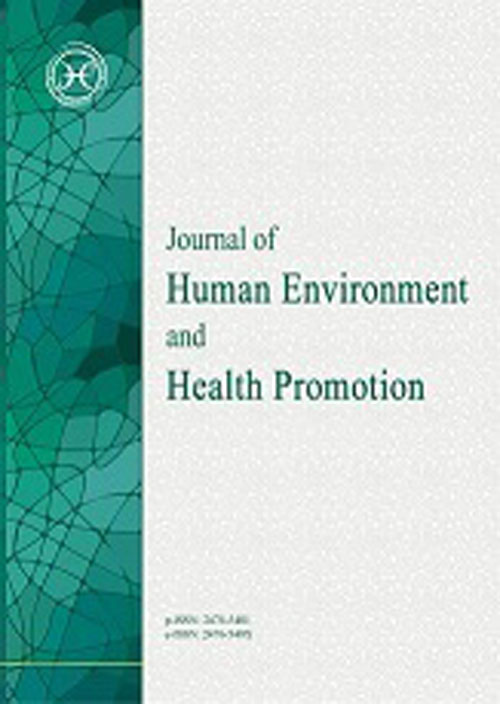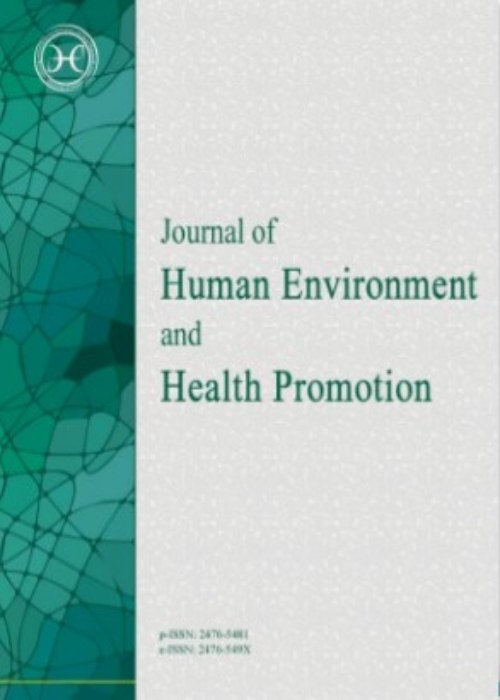فهرست مطالب

Journal of Human Environment and Health Promotion
Volume:7 Issue: 3, Summer 2021
- تاریخ انتشار: 1400/08/15
- تعداد عناوین: 8
-
-
Pages 108-119Background
During recent years various anthropogenic and natural activities contribute to high levels of heavy metals in environments. These toxic metals are accumulated in foods mainly in vegetables which consuming them may cause different fetal diseases among humans. Therefore, the main aims of this study were to review the heavy metals level in vegetables and to evaluate related human health risks indifferent parts of Bangladesh.
MethodsVarious keywords such as heavy metals, vegetables, and health risk were used to search published articles from 2015-2020 on heavy metals in vegetables (Searching Location: Khulna, Bangladesh). Twenty two articles were selected to review the present study.
ResultsIn this review, the level of Cr, Mn, Fe, Ni, Cu, Zn, As, Cd, and Pb in vegetables was considered for study which their level in many researches were above the safe limits recommended by joint FAO/WHO (Food and Agricultural Organization/World Health Organization) leading to health hazards for human being.
ConclusionThis study showed that vegetables cultivated in the contaminated areas were the main sources of heavy metals entrance to human body which pose severe health risks. Thus proper waste management systems should be suggested to reduce the heavy metals level in environments.
Keywords: Heavy metals, Vegetables, Health risks, Anthropogenic activity, Waste management -
Pages 120-128
Off-flavor, unpleasant and unacceptable tastes and odors, is a global problem in the fishery industries which causes many economic losses and health hazards. Off-flavors can be developed in the fish during the pre- or post-hunting phase. Pre-hunting off-flavors can be caused by environmental factors, feeding, and contaminants. However, post-hunting spoilage creates different off-flavors in the fish due to the growth of microorganisms, activity of enzymes, and oxidative processes. Identifying the sources of off-flavors can sometimes help the processors to perform corrective actions. Therefore, this study aims to discuss the different types of off-flavors, mechanisms, and effective compounds in their development. Further, the methods for identifying and reducing the off-flavors are introduced.
Keywords: Off-flavor, Oxidation, Contaminant, Fish -
Pages 129-137Background
Silybum marianum is considered as one of the valuable medicinal plants. This study focused on maximum recovery of total extractable compounds (TEC), anti-radical capacity (AC), and silybin content as a major phenolic compound using hydroethanolic solvent system (HSS).
MethodsThe HSS consisted of different ratios of ethanol (EtOH) and water (H2O). The AC was determined using spectrophotometric analysis. High-performance liquid chromatography was used for analyzing the silybin content. The cells morphology and the mass transfer kinetics were investigated using scanning electron microscope and Peleg model respectively.
ResultsBased on the results, the highest TEC (154.60 ± 2.4 mg/g), AC (39.19 ± 0.30 of % DPPHsc and 28.15 ± 0.51 of % OHsc), and silybin (4400 ± 33.00 mg/ kg) were obtained using HSS (80%v/v of EtOH). Moreover, high correlation was found between AC and silybin content. Mass transfer kinetics was successfully explained using Peleg model (R2 = 0.9970, RMSE = 2.274, and E = 1.22%). Further, intense cellular disruption during HSS caused accelerated release of bioactive compounds.
ConclusionThe HSS composed of 80% v/v of EtOH was found as an efficient system for successful recovery of bioactives which could be introduced as a natural ingredient for food and pharmaceuticals industries.
Keywords: Hydroethanolic solvent system, Silybin, Silybummarianum, Spectrophotometric analysis, Scanning electron microscope -
Pages 138-145Background
In this research, the adsorption efficiency of Cellulose (as a raw compound prepared from trash papers) and Cellulose Nanopolystyrene (CNP) as adsorbents for waste water treatment was investigated. Lead and cadmium ions as the pollutants added to aqueous solutions and a synthetic effluent solution was prepared.
MethodsThe effective factors influencing the adsorption process including the pH of aqueous phase and its ionic strength, the adsorbent dose, the duration of adsorbent, and time dependency have been assessed. The removal efficiency was assessed by determination of studied metal ions using a flame atomic absorption spectrometer before and after removal procedure.
ResultsIt was found that 0.1g of Cellulose as adsorbent removed 96.81%‚ 50.06% of Pb2+and Cd2+ from 45 mL of synthetic effluent solution at pH =5 after 30 min at 27°C, respectively. Moreover, 0.1g of the CNP removed 96.88%‚ 60.41% of Pb2+and Cd2+ from similar above-mentioned conditions. The CNP showed better adsorbent characteristics in the adsorption of Pb2+ and Cd2+ ions than the Cellulose. The Langmuir and Freundlich isotherm models successfully demonstrated the experimental observations for removing Pb2+ and Cd2+ ions by CNP as the adsorbent. The Dubinin-Radushkevich D-R) and Temkin isotherm models were better adapted than other used models for the adsorption procedure.
ConclusionThis research confirms the efficiency of treated Cellulose and Cellulose Nano-polystyrene (CNP) adsorbents from trash papers for eliminating Pb2+ and Cd2+ ions from synthetic effluent solution.
Keywords: Water treatment, Adsorbent, Poly¬styrene, Isotherm, Cheap adsorbents -
Pages 146-151Background
Considering the accelerating rate of HIV / AIDS during recent years in Iran, it is extremely important to assess the AIDS awareness among people to design appropriate health education programs. This study aimed to evaluate AIDS awareness of health volunteers and the women covered by Zanjan health centers.
MethodsThis was descriptive cross-sectional study that carried out in 2019. The population consisted of all married health volunteers (205) and the women (198) covered by Zanjan health centers. The target population was selected by purposive sampling method. A valid and native researcher-made questionnaire was used to collect the required data. The data was analyzed by SPSS (version 16) software.
ResultsBoth studied groups were homogenous in terms of age, education, and marital status. The findings showed that the health volunteers’ AIDS awareness was higher (70%) than that of the women. The difference was statistically significant.
ConclusionAlthough the health volunteerschr('39') awareness of AIDS was higher than that of the women, considering their role and participation in the education of people, this level of awareness is not acceptable.
Keywords: HIV, AIDS, Knowledge, Health Education, Health volunteer, Woman -
Pages 152-158Background
Milk and dairy products have an essential role in human health; however, they are easily contaminated and are likely to transfer pathogenic foodborne bacteria. Since traditional dairy products are very popular and are frequently used by the community, the aim of this study was to assess the contamination rate of raw milk and traditional dairy products by pathogenic bacteria and mold in Mashhad, Iran.
MethodsA total of 200 samples were collected from five districts of Mashhad, Iran in the summer of 2018. Samples were tested for Coliform, E. coli, S. aureus, Salmonella spp, Listeria monocytogenes, mold, and yeast according to the Iranian national standard methods.
ResultsResults showed that 65% of the samples were positive for at least one pathogenic bacteria. The prevalence of Coliform, Escherichia coli, Staphylococcus aureus, Listeria monocytogenes, Salmonella spp., molds, and yeast in all dairy products were 62.5%, 32.5%, 59.5%, 27.5%, 26%, and 100% respectively.
ConclusionThe results indicated that considerable numbers of traditional dairy products were contaminated with pathogenic microorganisms in Mashhad, Iran which emphasized the need for stricter hygienic rules and general education about the safety of traditional foods.
Keywords: Bacteria, Dairy products, Food contamination, Iran, Microorganism -
Pages 159-164Background
This study aims to determine the mental health status (depression, anxiety, and stress) and their determinants among Zanjan University of Medical Sciences (ZUMS) students during an early stage of COVID-19 pandemic.
MethodsThis cross-sectional study was conducted on 409 ZUMS students from April 20 to May 30, 2020 by convenience sampling method. The Persian version of the DASS21 scale was used to assess the level of participants’ mental health. Data were analyzed using SPSS-22 by student t - test and binary logistic regression. A P < 0.05 was considered statistically significant.
ResultsThe mean (SD) age of the participants was 22.35 (4.6) years and 66.3% of them were female. The findings indicated that 11.2%, 9 and 7.1 % of the participants had extremely severe levels of depression, anxiety, and stress respectively. Moreover, it was found that married students experienced less stress than single students (P < 0.05).
ConclusionThe results showed that studentschr('39') mental health should be considered during the COVID-19 outbreak since almost half of the students have experienced varying levels of stress, anxiety, and depression during COVID-19 pandemic of. It is suggested that the universities should plan to provide high-quality and timely psychological services in order to support the students.
Keywords: COVİD-19, Zanjan, Depression, Anxiety, Stress -
Pages 165-172Background
A lot of people consume traditional foods throughout the world, however there are concerns for their safety. The purpose of the current study is to evaluate the safety of traditional doogh (a traditional fermented dairy beverage) with respect to microbiological, chemical, and toxicological aspects.
Methods89 samples of traditional doogh from Khuzestan province, Iran, were analysed according to microbiological (Staphylococcus aureus, Echerichia coli, coliforms, mold and yeast), chemical (pH, total solid, fat, and salt content), and toxicological (aflatoxin M1, potassium sorbate, sodium benzoate, and natamycin) aspects.
ResultsResults showed that 89.88% of samples would be rejected according to the guidelines specified by the Institute of Standards and Industrial Research of Iran (ISIRI). 78 sample had higher mold and yeast than standard. The salt content of five out of 89 samples were higher than the established Iranian standard.
ConclusionThe most challenging problem was mold and yeast contamination, indicating poor hygienic manufacturing conditions. However, the unfavorable conditions for microbial growth such as low pH may prevent the toxic metabolites formation, and therefore, consuming it presents no major concerns to public health. Nonetheless, the authors suggest that efforts should be made to improve hygienic conditions in traditional doogh manufacturing environments.
Keywords: Dairy microbiology, Doogh, Fermented milk, ELISA, HPLC


